TESTING GROUND: SPATIAL LISTENING
‘As a listener, you can create a very effective space (and indeed an affective space) for someone to be able to speak into – to be able to work things out for themselves in. Those kinds of spaces can be rare to find and you don’t always need to provide an answer for them to be created.’
(Claudia Firth (co-edited with Lucia Farinati), The Force of Listening. Berlin; Errant Bodies Press. pp. 17.
“Bring questions into this space, and you will receive a reply, though not an answer.”
“Sacred places are no longer given to us, and they are rarely shared between whole communities. They are now containers for our own knowing, our own meanings. They don’t translate across minds. It falls on us to keep them.”
– Katherine May, Enchantment, p. 36 & 40
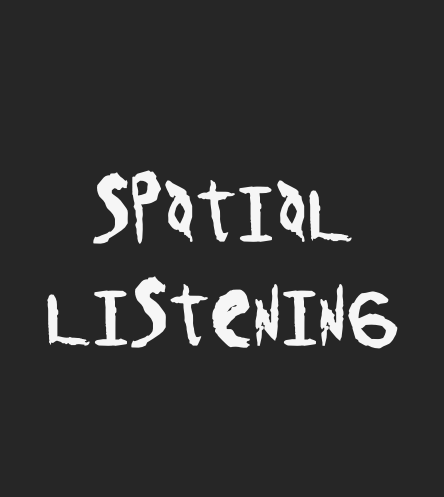
THE TYPEFONT USED IS CALLED 'MOTHER NATURE IS A LESBIAN'. IT IS CREATED BY BE OAKLY AT GENDERFAIL, AND IS BASED ON A PROTEST SIGN. IT IS OPEN SOURCE AND USED HERE AFTER ECONOMIC DONATION TO GENDERFAIL PRESS.
—
[attempted digital space for exercising spatial listening….]
[What kind of listening is taking-place, right here and right now – in the digital almost ghostly space?]
—
FOGS AND DEAF DOGS
[‘Title’ for a power-point presented by Louise Vind Nielsen as part of kick-starting the week exploring spatial listening]
[Maybe also a guide and mantra for a listening space/a practice of spatial listening]
—
Questions that might guide engagement into ‘spatial listening’:
How does one listen to a place and space? How may one not only listen for the audible and inaudible sounds of a space, but also the missing and silenced sounds and voices and their histories; traumatic as well as hopeful and speculative?
How do spaces and places listen back at us – how do they always already affect, situate and condition our being in the world?
In what ways are we orientated by spaces and places before we make orientations of these spaces and places?
In what ways can we (re)position our bodies and practices differently in a particular space? How may shifts in our awareness of space and place alter our listening, and how may listening be a tool for become aware of the spaces and places we inhabit together with uncountable other entities, whom always already are listening right here with us?
Score for a possible aggressive territorial listening action:
(A chance to become aware of, confront and alter the spatial dimensions of listening…)
For one person, or a dispersed group or people.
Time and place undisclosed – preferable during dark/night time or rush-time, in a city centre or remote nature.
—
Sit, stand or lay down, in a manner that is suitable and blends in in an environment.
Listen (secretly, as an instrument, as a weapon ready to be fired).
Extend your attention to someone, something, somewhere. Surround it. Infiltrate it.
Insist on your listening (you are now altering the circumstances of the person, the thing, space, and place – the territory).
Get out of the environment before you are identified as the agent of aggressive listening.
—
This happening is not to be proclaimed and transmitted. It must happen in secrecy.
Up-starting ritual #1:
[A series of rituals/practices/exercises/check-ins… to mark and attune each ‘workshop’ day. Each ritual will last 15 minutes.]
For the brief time of 15 minutes we tested the score for Influential Spatial Listening (in short form) in the space outside of Art Hub Copenhagen.
Our bodies knows how to locate and navigate space through sound – we came into a sounding world as a sounding being.
Non the less we a less trained to solely do this – often we allow our visual orientation to dominate our ways of structuring and designing space.
What happens when we blindfold ourselves and start sending out clicks – generating a kind of ‘echo-location’ way of orientating oneself in space – how do we come curious, vulnerable, slow and abnormal in the ‘eyes’ and ‘ear’ of others?
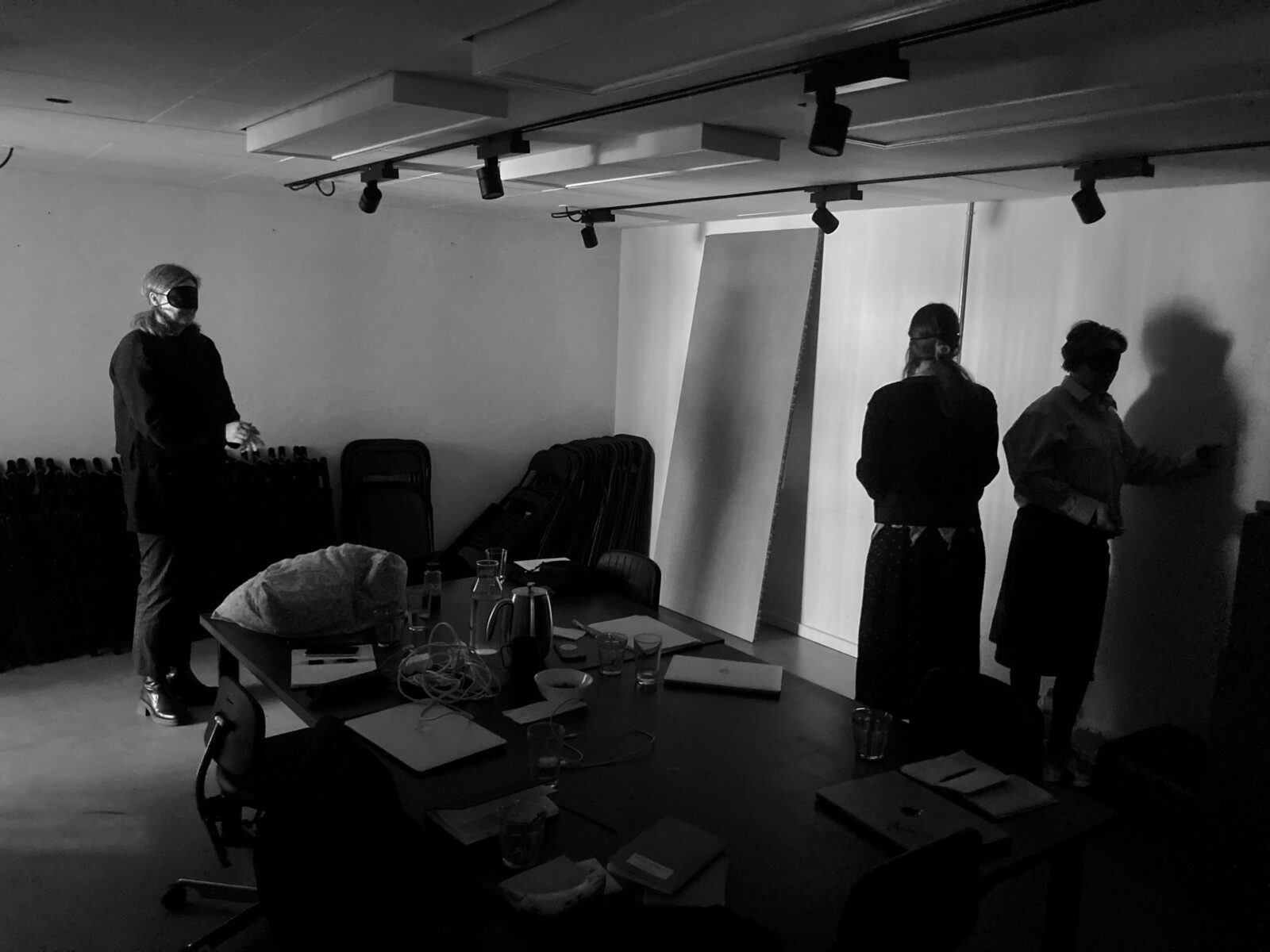
Exercise exploring location and navigation of space through sound.

Exercise exploring location and navigation of space through sound.

Performance artist Nana Francisca Schottländer once said, in a Conversation for Listening, that:
“An intentional space, which is not already filled by something, but which invites something. And in some ways, I guess, to bring it back to listening, I guess that’s also how I think about listening, is creating that space or that invitation in me, in my senses, in the space where I receive the world. That makes what happens there vibrant, because it is intentional, it doesn’t just land as a jumble, it is given space, it is honored in a way. And that honoring or that invitation makes it come alive in different ways.”
As part of this fourth week of the Testing Ground residency we have the fortunate opportunity to participate in a performance lecture at Inter ArtsCenter, Malmø, with title: Thinking Together: Sedimentality and Decolonial Redoings – by prof. Rebecca Schneider and multidisciplianry performance artist Emilio Rojas.
Here they shared and discuss their ongoing exploration of decolonial listening, site and non-site in land art, and the question of “reenactment” when “the body” or flesh is also “the earth”.
This performance lecture been a valuable resource of information and inspiration.
We were also able to participate in a Free Lunch at Art Hub Copenhagen, hosted by visual artist Julie Nymann in conversation with the Foreperson of the Dyslexia Association, Gry Kaalund Nicolaisen and PhD student at Roskilde University, Julie Lund Jensen.
The conversation explored Julie Nymann’s work exploring The advantages of being dyslexic. The lunch and conversation was an inspiration into how non-normative navigation of spaces, systems and expectation (fx being with dyslexic orientation), while also recognition the struggles that comes with it. It was also a reminder to the normative majority about reflecting on what disadvantages there is within being part of a majority.
(Spatial) Walking Event
As a exercise for the 4th session of the Study Group for Listening we re-appropriated and explore the Walking Event, 1965, by Milan Knížák.
How is walking around a circle a space-making and listening generative practice? What traversing and exchanges of different inward/outward, between-nesses, and beside-nesses, fast and slow, public and private, energies might be travel trough such space?
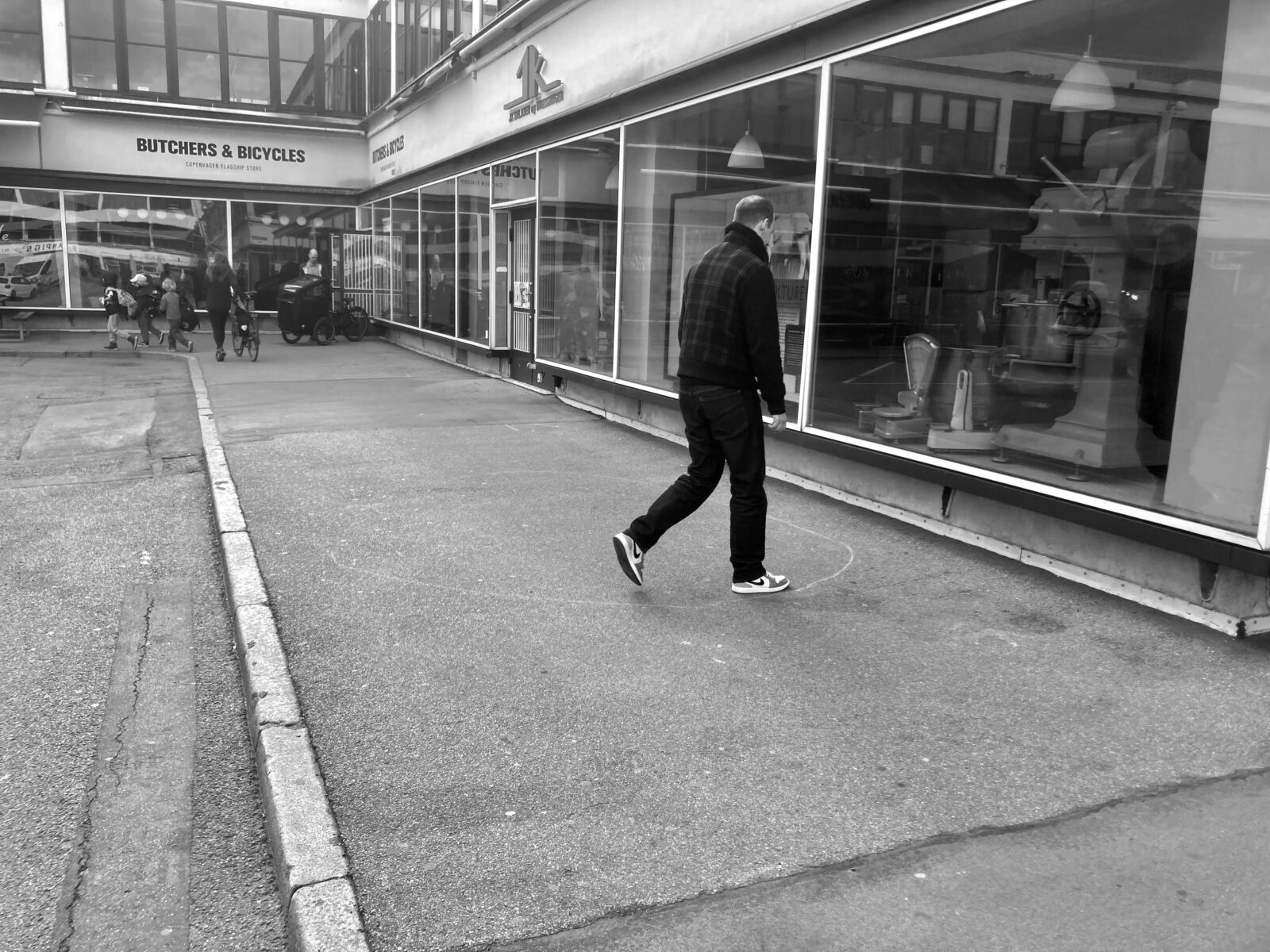
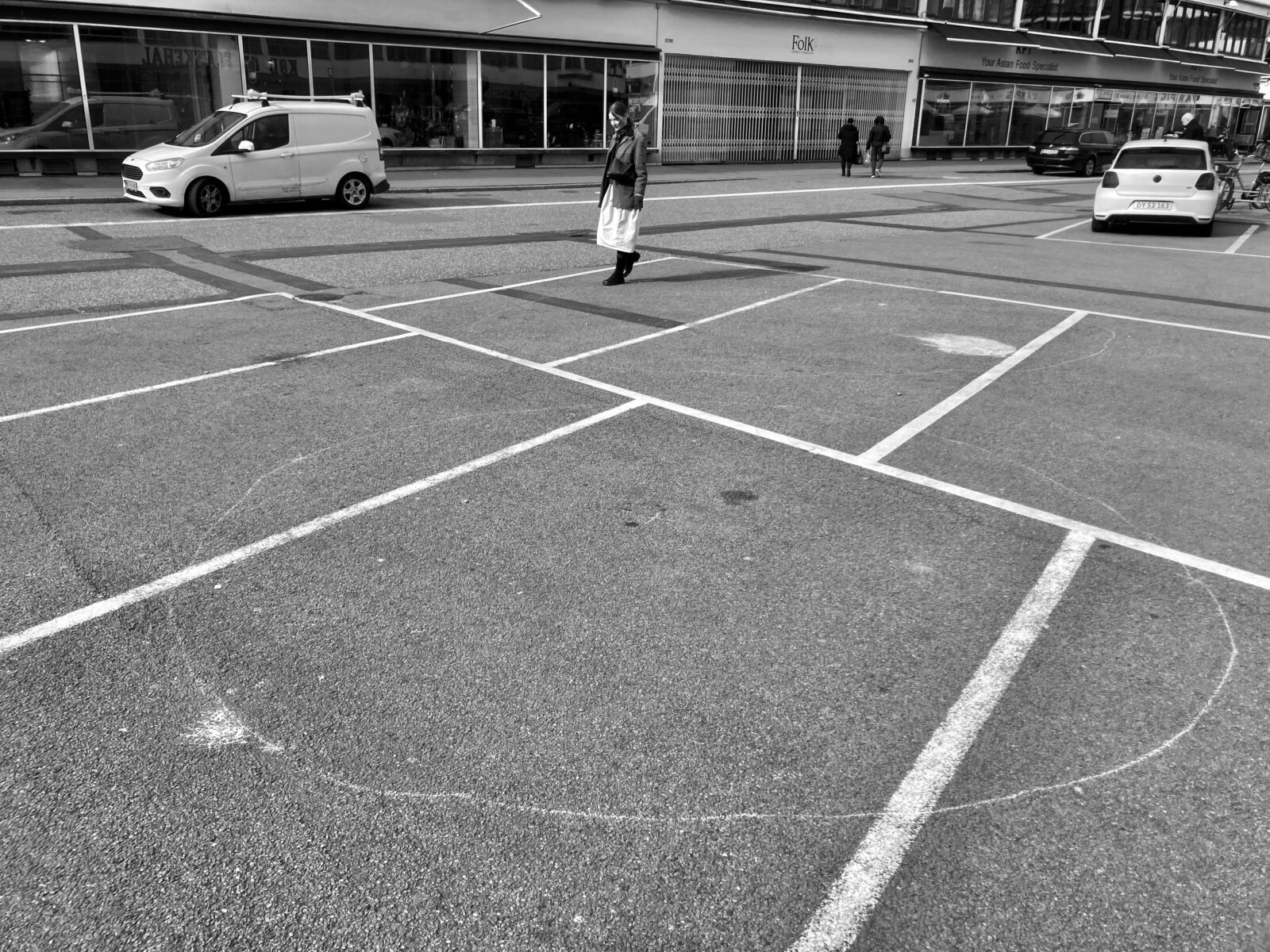
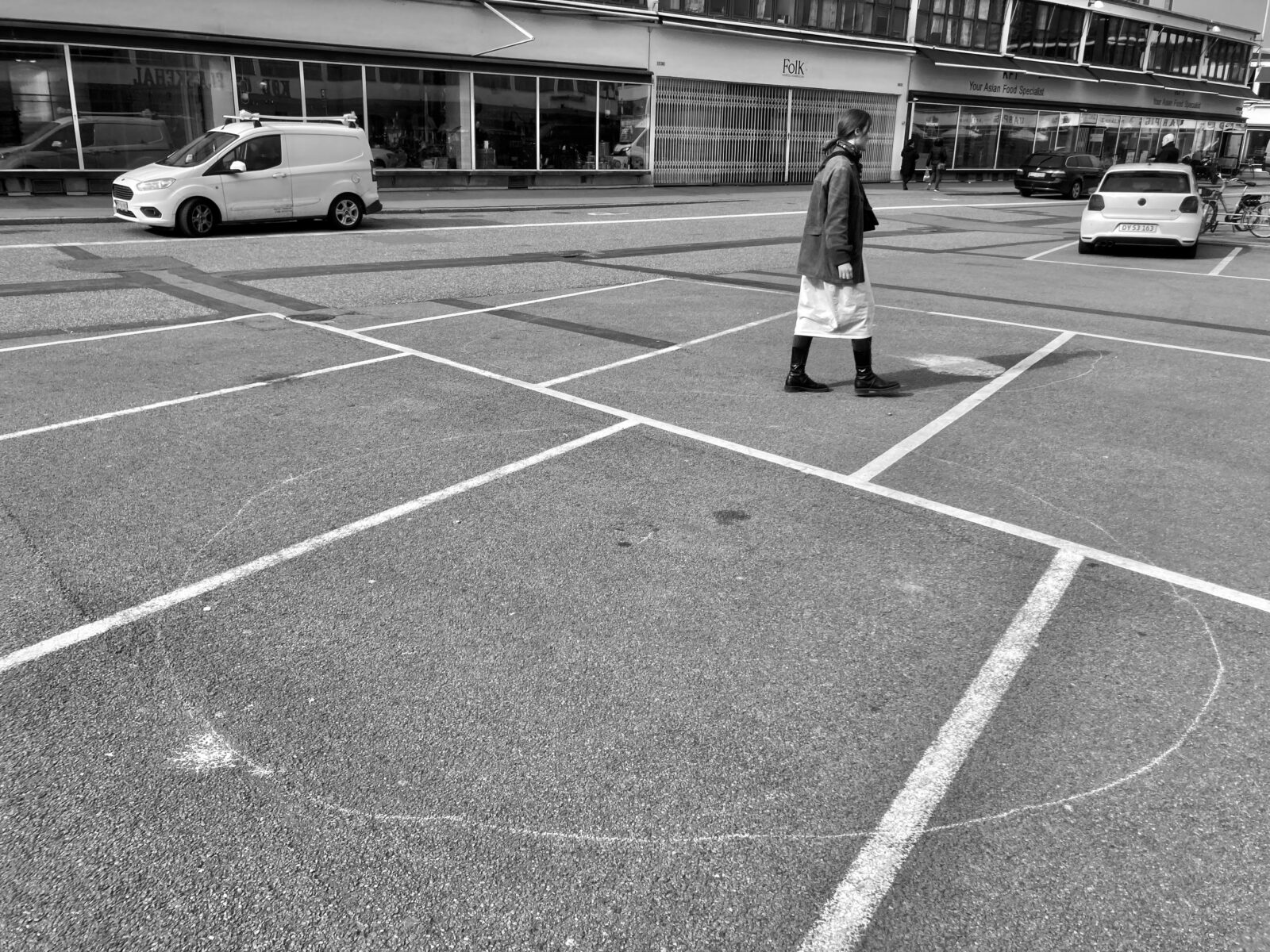
Listen with the deepest spaces of the ocean.
—
Listen with the space created by a single breath.
Up-starting ritual #2:
[A series of rituals/practices/exercises/check-ins… to mark and attune each ‘workshop’ day. Each ritual will last 15 minutes.]
Part I
5 minute writing exercise.
Write a list of barriers. Any sort of border or edge that serves to define a type of space.
Part II
10 minute inhabitation exercise.
– Find a space you like. Inhabit it.
– Define it. Separate it from what’s around it. Define its edges.
– Write a 4-step guide on how to settle in to this space.
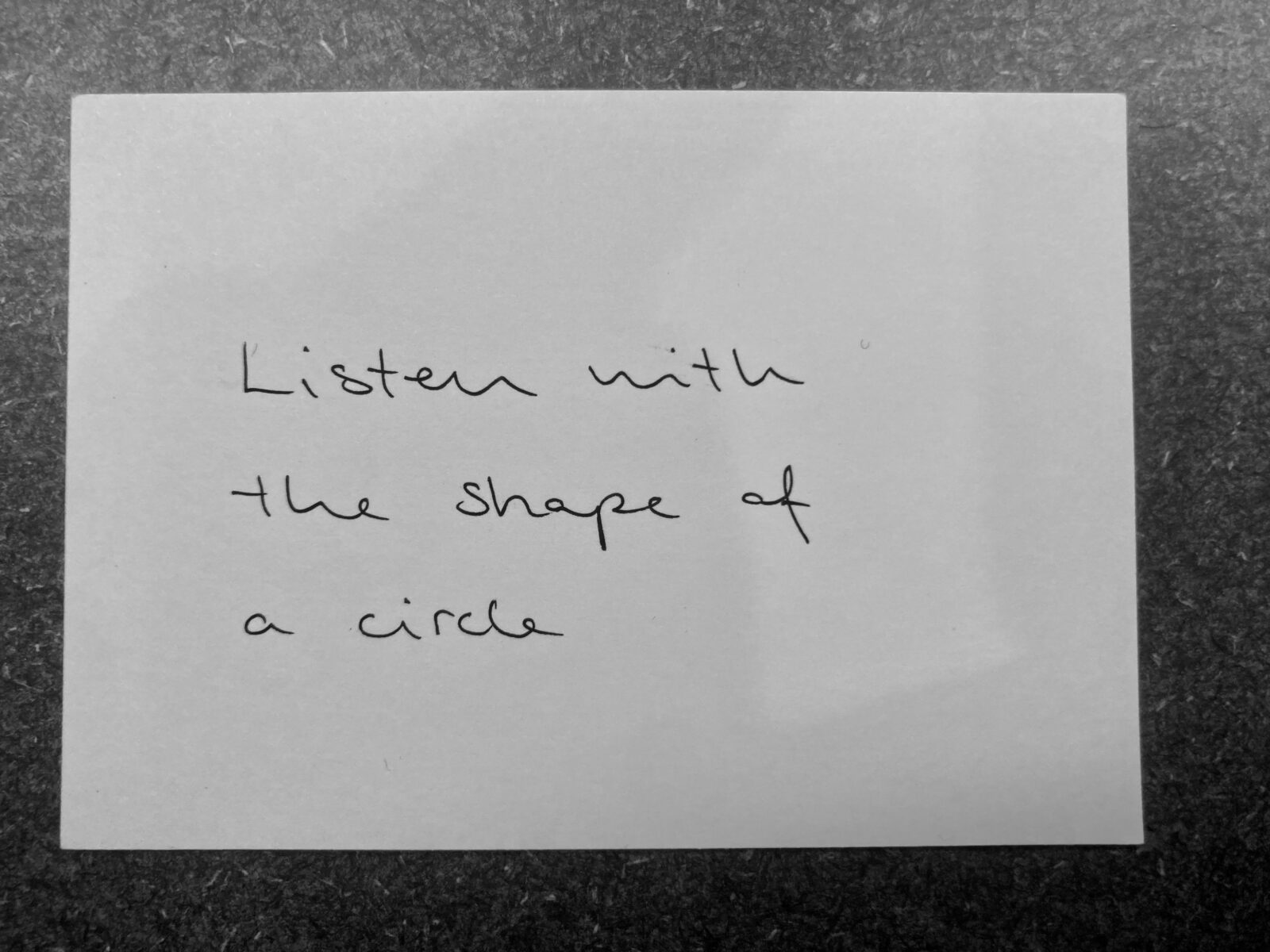
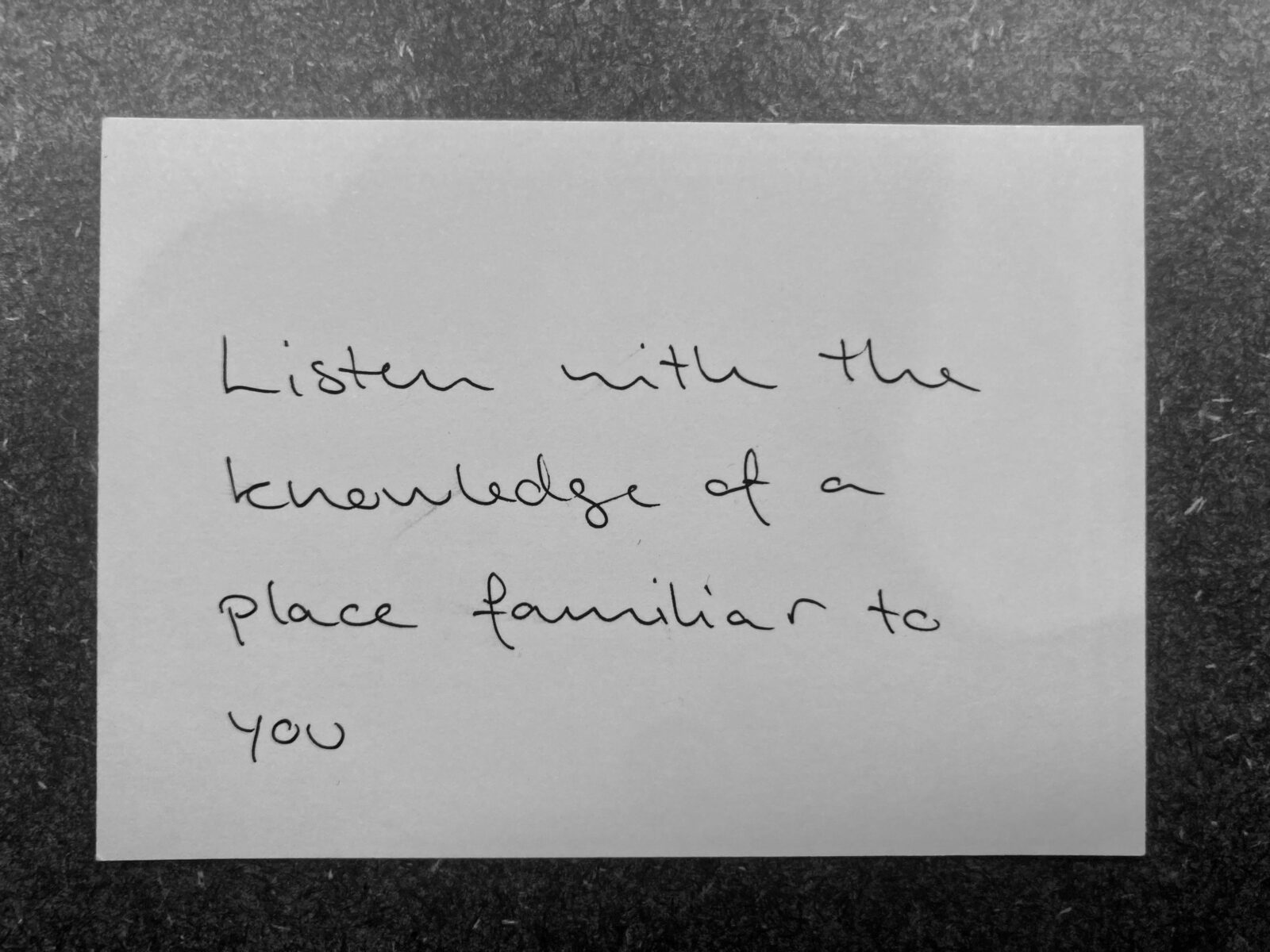

Spatial Listening – group conversation
Wednesday the 17th of April
The vault at Art Hub Copenhagen
1 hour and 7 minutes.
Present: Louise Vind Nielsen, Elisabeth Holager Lund, Amalie Sejersdahl, Randi Lindholm Hansen, Lukas Quist Lund.
Unedited AI generated transcription (apologies for spelling mistakes).
Conversation in Danish.
[To be revisited, sorting out speakers and fragmentized later on].
Up-starting ritual #3:
[A series of rituals/practices/exercises/check-ins… to mark and attune each ‘workshop’ day. Each ritual will last 15 minutes.]
Performative mapping of The Meatpacking District
“Performative mapping practices question traditional mapmaking for objectifying methods, and suggest instead self-reflexive methods. In doing so, performative mapping practices tend to unfix dominant knowledges of place and generate other multiple subjective, resistant, and critical knowledges.”
Aslihan Senel, Performative Urbanism – Generating and Designing Urban Space
There are many ways to work with performative mapping. At this up-start ritual we followed this guide:
Choose a theme from the list
Public/private
Animals
Nature
Enclosure
Limitations
Sound/changes in sound
Intangible boundaries
Material boundaries
Go out and experience the area as if you were an animal, how nature can live in an industrial area, where private and public spaces meet and so on.
Write words, poems, observations on small cards and gather after 15 mins. Collect your cards and create a different map of the area you are exploring.
Mapping the spatial listening concepts, practices and possibilities from the testing ground week:
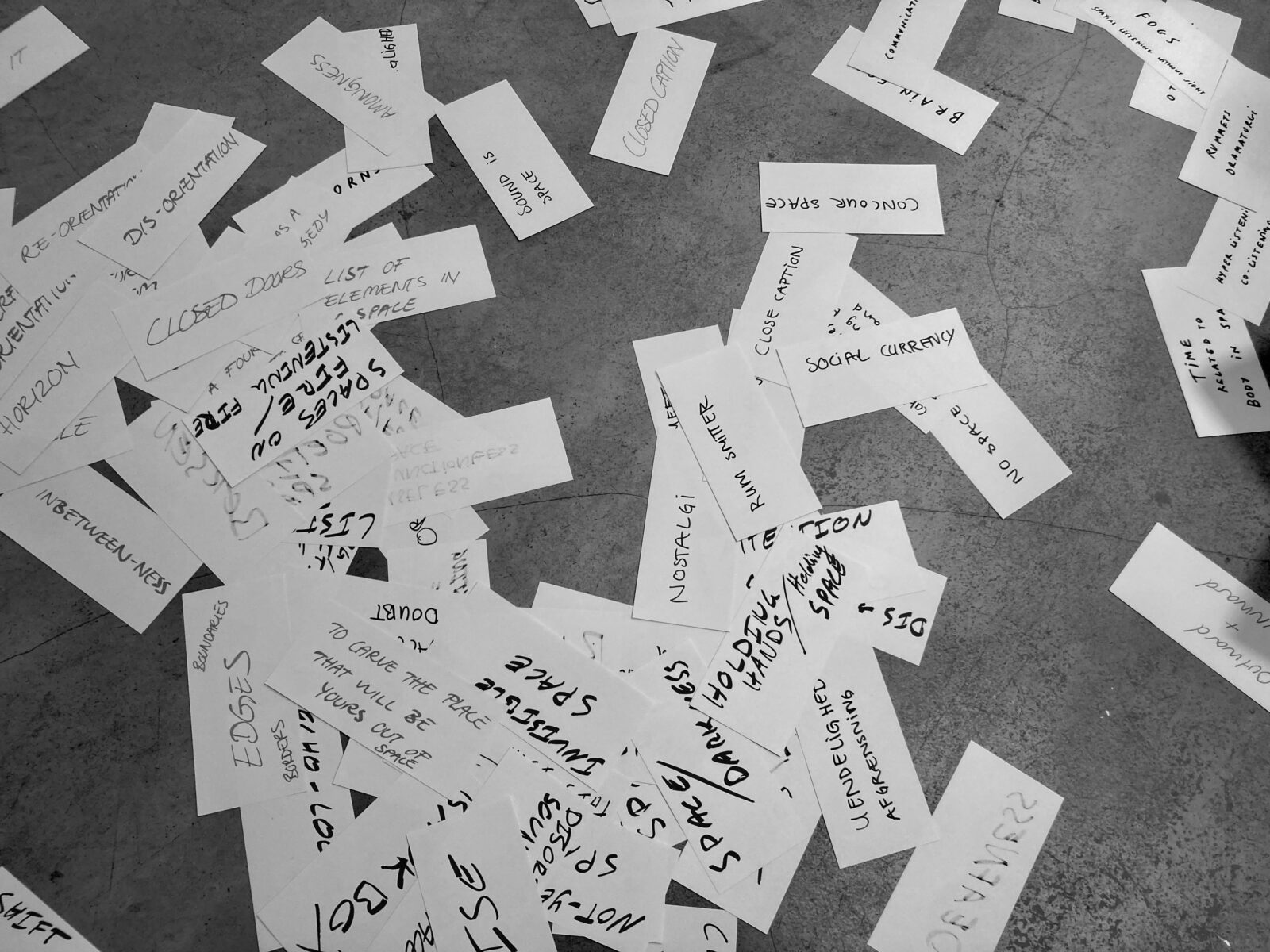

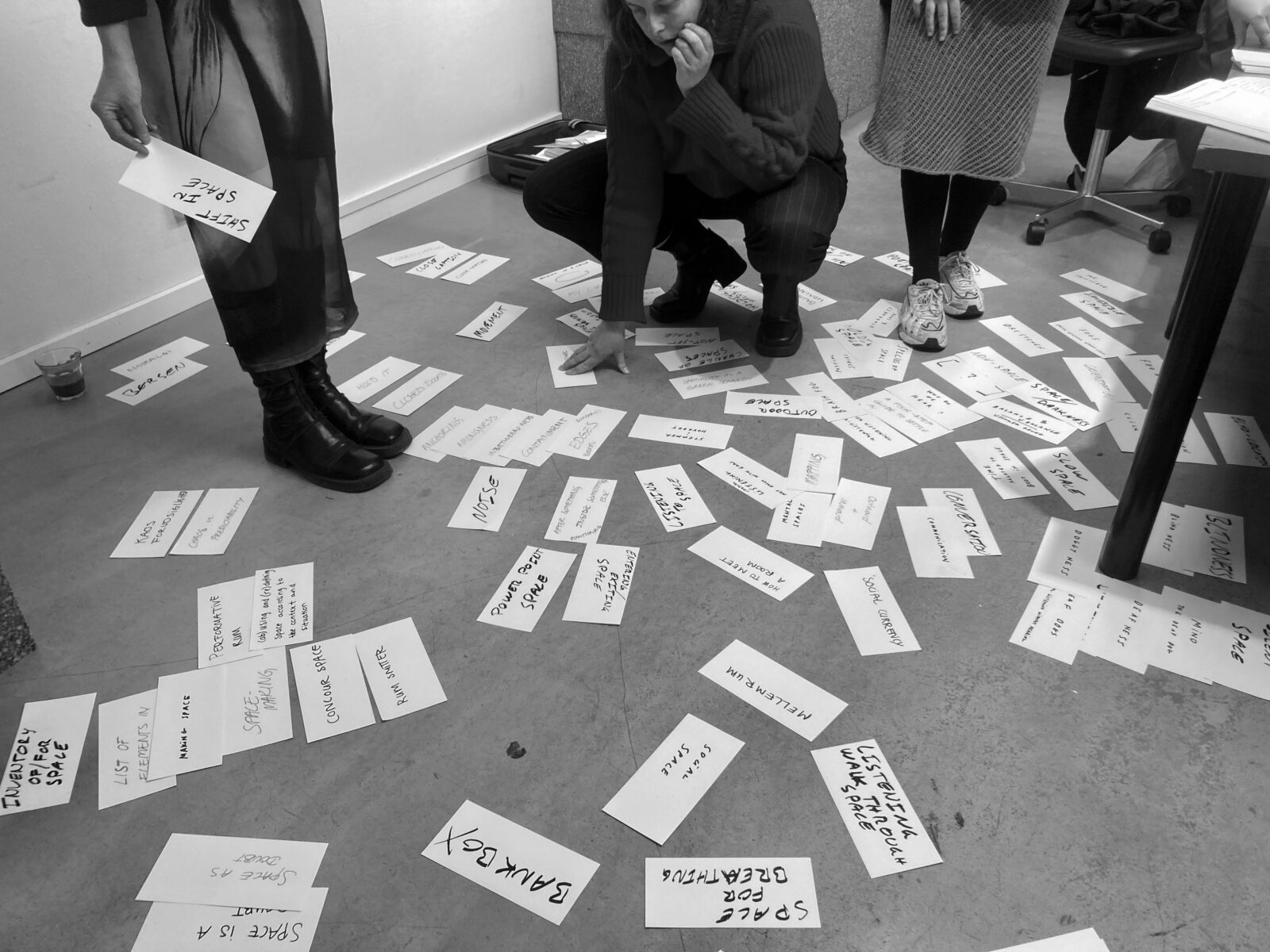
Slowly, and spatially, planning and shaping a possible script/program for Listening IV:
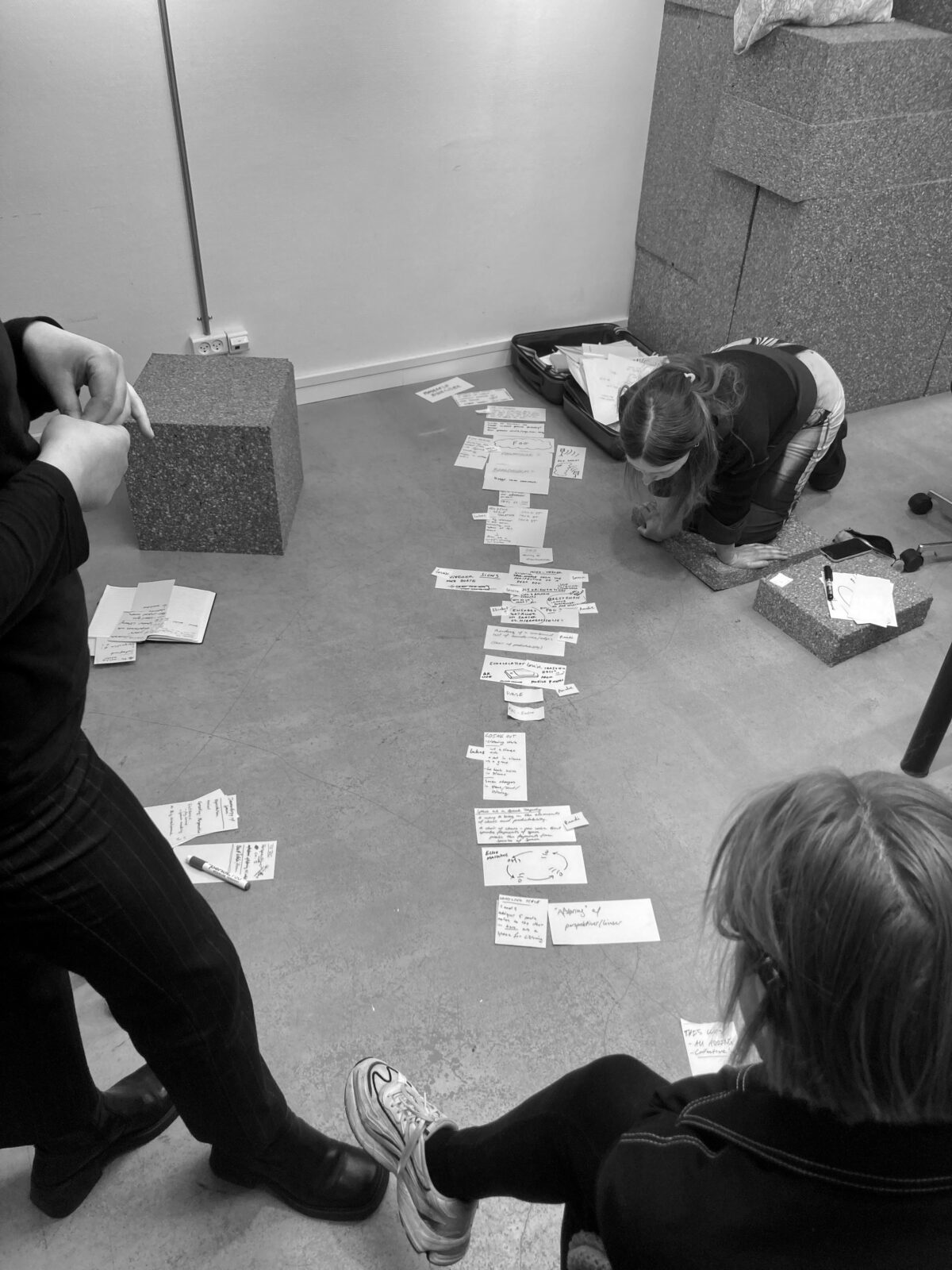
In what ways does it affect your being – your spatial presence and capability to listen – if you engage with a space, a situation, with a certain perspective?
In relation to explore spatial listening could such perspectives be:
Among-ness
Around-ness
Back-ness
Before-ness
Beside-ness
In-Between-ness
Outward-ness
In what way does it affect your behaviour and your listening to encounter a sign stating:
This room
is being
audio recorded
(but only for caring, artistic and internal uses)
(in what ways does it affect the space, and the activities taking place here, that the space is being audio recorded?)
Invitation to enter:
This is a listening space
First, we invite you to explore and listen to this space (in silence).
You may move around as you like.
Second, please go to the main room. Take what you need of furniture to listen with, and settle down where you find yourself comfortable/recognised in space.
(Wait.
Blend in.)
List of Edges
[Read out loud at Listening Event II to others to listen to, orient themselves by…]
[The list is site- and process-specific to the room of Art Hub Copenhagen, the people in it, and the process of arriving there, shaping and holding it.]
edge / line / barrier / mental barrier / rope / border / fence / hedge / chicken wire / curb / egg shell / chalk line / eye line / skin / ditch / horizon / contour / outline / wall / brick wall / to build a wall / floor / ceiling / peel / coastline / window / list / square / circle / outside / inside / a gaze / an energy / a mood / aura / being locked in / escaping / the uncertainty of freedom / certainty in boundaries / predictability / I build a shell / everything I fear / everything I distance myself from / claustrophobia / the brain alone / the cranium, to remain whole to keep matter in / prevent seeping out / facade / prejudice / reservation / misunderstandings / garland / light chain / chain / railing / doors / the closing of a door / pillows / social expectations / own expectations / sound / light / water / air / fire / legs / string / money / glass / smell / darkness / ethnicity / stairs / slides / waterslides / the undefined transition from where you stand and the space above you / knowledge / lack of knowledge / bag / envelope / the inside of a hand held up / mirror surface / the surface of the screen / the inside of my pants / the inside of my shirt / perspective line / your face
Score for: Going Out – A Listening Walk
Performed with the guests of Listening Event IV.
The group gather together inside a room
Stands together in silence – invite the group to close their eyes – invite the group to listen to this space – stays like this for min. 2 minutes
–
The group follows the ‘facilitator’ outside, into the street
Here the group stands together again – invite the group to close their eyes – invite the group to listen to this space – stays like this for min. 2 minutes
–
The group follows the ‘facilitator’ inside again, into the indoor room
Here the group stands together again – invite the group to close their eyes – invite the group to listen to this space – stays like this for min. 2 minutes
–
The facilitator can invite the group to:
“Ask for yourself: how did you experience the changes of space – from the indoor, to the outdoor, from being in movement to standing still, from fewer sounds to more and larger sounds – a from a space of known sounds, to a space of unknown sounds, both outside and inside of yourself – how have the space of the inside changed after coming back in – how did going out to listen change the listening of coming back? In what ways has the group dynamic change after moving through spaces, and in what ways has your listening changed? What is now the relationship between your listening and sense of space? Hold these questions for yourself.”
[Additional question (maybe for when the group is outside): “Now, when being outside, and maybe with your eyes close, how large is this space? How far away can you listen? How is your listening shaping the space you are in?]
—
EXCERPTS FROM GEORGES PEREC’S SPECIES OF SPACES AND OTHER PIECES
[Read out loud to guests at Listening Event IV]
—
Score for: Whisper Piece
Performed with the guests of Listening Event IV.
Take a moment to note down for yourself how the ‘perspective’ you received outside when arriving, before entering the space, has affected your engagement with the space and your own listening. Note down something you will be comfortable with whispering to someone else.
–
Whisper your notes to a person next to you. The one that have received a whisper, will now whisper to a new one, etc.
—
[Not whispering something, or whisper in a non-understandable way, is also equally alright. Focus on the sensation of the whispering, both as sender and receiver – allow the whispering to affect the space, its ethic and energy.]
Other quotes:
“To start with, then, there isn’t very much: nothingness, the impalpable, the virtually immaterial; the extension, the external, what is external to us, what we move about in the midst of, our ambient milieu, the space around us.”
(George Perec, Species of Spaces and Other Pieces, Foreword)
—
“I would like there to exist places that are stable, unmoving, intangible, untouched and almost untouchable, unchanging, deep-rooted; places that might be points of reference, of departure, of origin:”
(George Perec, Species of Spaces and Other Pieces, Space (Continuation and End))
—
‘ARCHITECTURE IS IDEOLOGY
ARCHITECTURE STRUCTURES ACOUSTICS
ARCHITECTURE IS SOUND DESIGN
SOUND DESIGN IS LAW AND ORDER
WHEN YOU CAN’T DESTROY THE BUILDINGS
CHANGE THE SOUND,
CHANGE THE LISTENING’
(Tobias R. Kirstein, Claus Haxholm & Rasmus Holmboe, Handbook of Aggressive Listening. Self-published artists’ book, 2018.)
—
“Listening, as what brings attention to the said and the unsaid, slowing the time of speech with greater sense for the missing and the previously inarticulated, to name those dimensions often hidden from view, assists in creating a “holding environment” – a supportive space of attention, a slowing to allow for dwelling upon the said; to draw out not only the meaningfulness of spoken, but to also give room for its resonating silence […]; it draws into the arena of attention and understanding – not only through care and empathy but also through its collaborative capacity – giving way to an intensity of critical or associative thinking, for bridging knowledges, for thinking together, attend the withdrawn and the not-yet spoken. Within such holding environments, the possibility to hear differently is given a chance.”
(Brandon LaBelle, Acoustic Justice. London: Bloomsbury, 2021. pp. 9.
—
“Althrough we usually think of a soundscape as a collection of sonic events, it also includes the aural architecture of the environment. The experience of listening to a sermon in a cathedral is a combination of the minister’s passionate articulation and spatial reverberation”.
Blesser, Barry & Salter, Linda-Ruth, Spaces Speaks, Are you Listening? Cambridge, MA: The MIT Press, 2006. pp. 15
—
“The lines that allow us to find our way, that are “in front” of us, also make certain things, and not others, available. What is available is what might reside as a point on this line. When we follow specific lines, some things become reachable and others remain, or even become, out of reach. Such exclusions – the constitution of a field or unreachable objects – are the indirect consequences of following lines that are before us: we do not have to consciously exclude those things that are not “on the line.” The direction we take excludes things for us, before we even get there.”
(Sara Ahmed, Queer Phenomenology, 2007:14-15).
—
‘You are so young, so before all beginning, and I would beg you, dear sir, as best I can to have patience with everything unresolved in your heart and try to love the questions themselves as if they were locked rooms or books penned in a language most foreign to you. Don’t search for answers now that cannot be given because you could not live them. And it is about living it all. Live the questions now.’
(Rainer Maria Rilke, Letters to a Young Poet).
—
‘I am not listening to anything anymore, but only hear time passing as my space. In a sense I am listening to listening. The line becomes bare and the air rarefied in these small hours. […] The space has shrunken to its time only. There is nothing left to move: I am only ever now and quite brutally so. Sound apparent in durational work. I am kept painfully in the now for a long time. I am caught staring, captivated by the realization of my own tie flowing away on the spot of my listening. I am enveloped in my own process of being forever now. It is in this now of durational sound that the notion of timespace becomes perceptible rather than conceived as an abstract concept.’
(Salomé Voegelin, Listening to Noise and Silence, 2010:125)